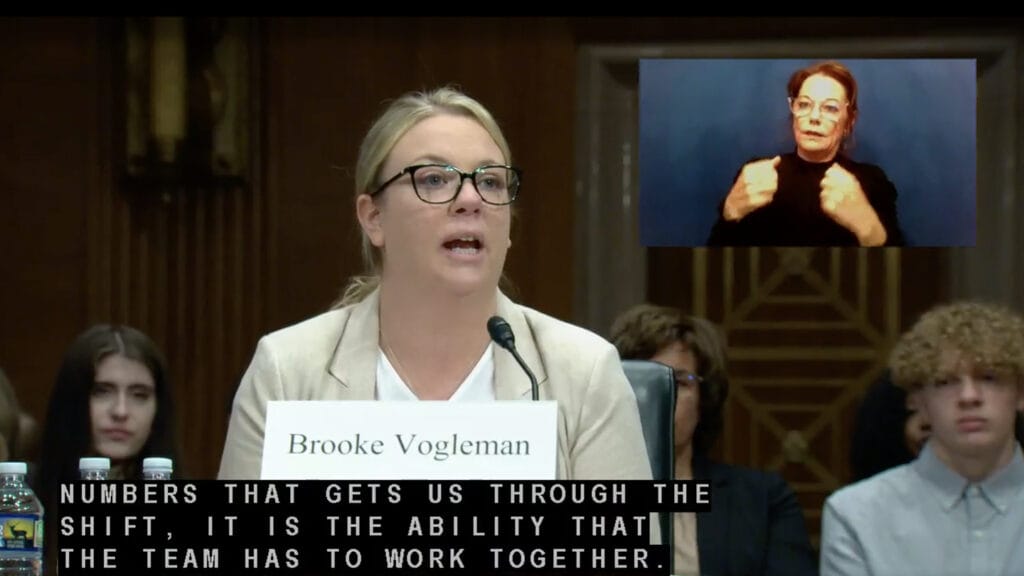

Key Democratic leaders Tuesday positioned new long-term care workforce legislation as a way to support nursing homes when a first-ever staffing mandate is finalized.
Sen. Bob Casey (D-PA), chair of the Senate Special Committee on Aging, and two colleagues introduced The Long-Term Care Workforce Support Act Monday. It aims to increase the number of direct care professionals, provide new pathways to enter the LTC workforce, improve pay, and identify effective recruitment and training strategies.
During a related hearing Tuesday morning, Casey drew attention to understaffing in nursing homes in particular. He called out testimony from Jasmine Travers, PhD, RN, assistant professor at NYU’s Rory Meyers College of Nursing, who reported that understaffing has been linked to increased falls, more emergency department visits and inappropriate medication use in skilled nursing facilities.
“I think it’s pretty clear that we’ve got a problem with understaffing,” Casey said in his closing remarks. “I’d be the first one to say, with a new policy that addresses minimum staffing, we also should provide the support that folks need to have that staff in place. And that’s something where the federal government has not met its obligation for a long, long time.”
Congress divided
Casey is among several Democrats who have given full-throated support to the Biden administration’s proposed mandate, despite protests from providers and many lawmakers from rural areas that enough nursing staff aren’t available.
While existing bills in both houses of Congress would block the mandate citing concerns about patient access to skilled nursing care, other lawmakers have already turned their attention to building a pipeline of nursing home workers.
The Nursing Home Workforce Support and Expansion Act would provide $400 million annually in workforce grants to help states improve pay, benefits, education and retention for nursing home workers. That bill, introduced last week, has the support of the nation’s two largest nursing home advocacy organizations.
So do other bills that create nursing home-specific supports, such as legislation that would give temporary nurse aides working in nursing homes 24 months to become certified nursing assistants; a bill that would limit lockouts that prevent some nursing homes from training their own staff; and a proposal that allows for the recapture of unused visas from previous fiscal years to assign to nurses, doctors and their families.
Clif Porter, senior vice president of government relations for the American Health Care Association/National Center for Assisted Living said Tuesday that it is critical for the federal government to “support the entire long-term care profession rather than exacerbate the growing caregiver shortage and limit access to care for our seniors and individuals with disabilities. We need programs and resources to fix this labor crisis, not unfunded requirements and regulations.”
“Ninety-nine percent of nursing homes currently have open jobs, despite increasing wages at rates higher than any other healthcare sector,” Porter added in a statement. “However, the labor market — especially in rural communities — does not exist to meet the demand for caregivers. With a rapidly growing elderly population, this caregiver gap will only widen unless our nation’s policymakers make a significant investment in our nation’s seniors and those who care for them.”
Several witnesses Tuesday spoke to efforts skilled nursing operators, local training organizations and educational institutions are making to reduce barriers to workforce entry and to improve retention.
Staff shortages acknowledged universally
Brooke Vogleman has spent her entire 15-year career in long-term care, starting as a CNA. Her former employer, American Senior Communities, provided the scholarship she needed to train for her LPN credentials, while her current employer is paying for her to complete her RN degree. Vogleman is now a regional clinical education coordinator with TLC Management in Indiana.
“I have seen the commitment from the long-term care profession to support practitioners like myself. I have also seen practitioners come and go for myriad reasons,” Vogleman said. “I have also seen what happens when long-term care facilities lack the workers and the resources as well as government support, like during the pandemic. Many of my colleagues got burned out and left the profession.”
She said the lack of interest and qualified candidates in the sector has led to increased reliance on agency, which could increase again if a mandate is imposed.
“I am hopeful that federal policymakers, including the members of this committee, will help us address this challenge through targeted investments and not blanket mandates,” Vogleman said.
Later, Sen. Elizabeth Warren (D-MA) pressed Travers on the need for higher paying, better quality jobs to attract more individuals to careers in skilled nursing. Travers acknowledged that the current staffing requirements for “sufficient” nurse coverage may undercut some quality drivers, such as being able to deliver certain medicines if an RN is not on shift.
But she also said workforce improvements could be incentivized through value-based payment or similar initiatives, and that providers should empower workers to advance through new and more flexible pathways.
Asked by Warren if the nursing home industry’s objections to a staffing mandate based on nurse shortages are valid, Travers said most nursing homes agree with consumer groups that more nurses are needed. The difference in opinion is over whether that should be mandated.
“I do believe that nursing homes believe that we do need staff. It’s just that there’s not support to be able to provide that staff,” she said. “That’s where this new bill that just was introduced … comes in.”
Katie Smith Sloan, president and CEO of LeadingAge, said Tuesday that “the devil is truly in the details” of the bill.
“We urge policymakers to pay attention to necessary refinements on particular issues such as funding for the education and training initiatives needed to build and sustain the workforce and investment in coordinated state and federal infrastructures to ensure programs achieve their desired goals,” Sloan said in a statement.
She also offered 12 pages of formal comments to the committee.




